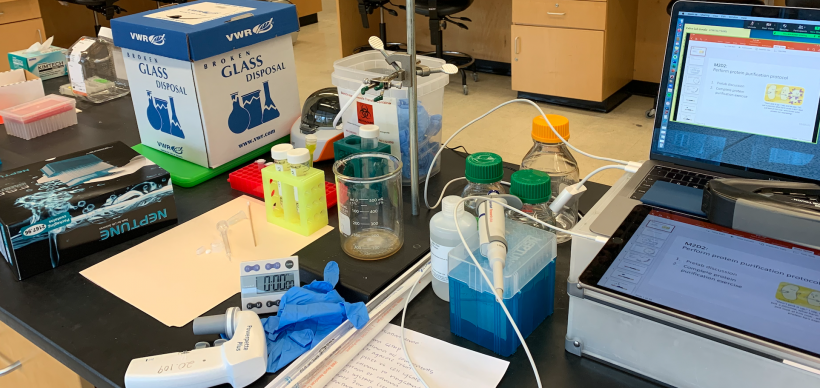Difference between revisions of "20.109(S21):M1D4"
(→Introduction:Sequencing) |
(→Introduction:Sequencing) |
||
| Line 4: | Line 4: | ||
==Introduction:Sequencing== | ==Introduction:Sequencing== | ||
| − | |||
| − | |||
| − | |||
| − | |||
| − | |||
==Protocols== | ==Protocols== | ||
Revision as of 21:16, 8 January 2021
Contents
Introduction:Sequencing
Protocols
To use SnapGene software off campus you must log into a VPN connection prior to opening the SnapGene. Here is the link to the VPN download and installation instructions. Also you will need to update the SnapGene license number if you have not opened the application since March. The new license information can be found here.
We have also posted instructions for DNA alignments using benchling on the class data page.
Part 2: Align scFv sequences
You will analyze sequence of clones that were previously submitted. Your goal before the end of today is to analyze the sequencing data for two potential scFv clones and decide which clone to proceed with for the characterization of lysozyme binding.
Retrieve sequence results from Genewiz
- We retrieve our sequencing data from the Genewiz website. The information was uploaded to the Class data page.
- Download the zip folder with your team sequencing results and confirm that there are 8 files saved in the folder.
- For each sequencing reaction, you should have one .abi file and one .seq file.
- Open one of the .abi files.
- This file contains the chromatogram for your sequencing reaction. Scroll through the sequence and ensure that the peaks are clearly defined and evenly spaced. Low signal (or peaks) or stacked peaks can provide incorrect base assignments in the sequence.
- Open one of the .seq files.
- This file contains the base assignments for your sequencing reaction. The bases are assigned by the software from the chromatogram sequence.
- The start of a sequencing reaction result often contains several Ns, which indicates that the software was unable to assign a base. Given the chromatogram result, why might the software assign Ns in this region of the sequence?
- Include all of your observations in your Benchling notebook. You can also attach the files to your entry.
Confirm svFc sequence using SnapGene
You should align your sequencing data with the known sequence for clone Ab31375. To generate higher affinity binders to lysozyme, we generated a library using error-prone PCR mutagenesis of the scFv region of Ab31375. An error prone library generated with the conditions described on M3D1 should yield one to nine mutations per scFv gene. We will now align our sorted sequences to Ab31375 to see if they have amino acid substitutions which could yield altered binding properties to lysozyme. Watch this tutorial video from Snapgene for an introduction to aligning to a reference DNA sequence.
- Open the annotated clone Ab31375 file that worked on in Part 1.
- From the 'Tools' menu choose 'Align to reference DNA sequence' then 'Align Imported Sequences'
- Select the .ab1 files from both clones.
- In the top left panel check the box next to the two files (the forward and reverse sequence) from one of the clones.
- This populate the sequences and trace data in the lower right panel. Use the grey scroll bar at the bottom of this window to move along the alignment.
- Click the grey triangles to the left of the sequence name to expand the view sequence or trace information.
- Click on the sequence or trace icon to toggle between views.
- Place your cursor in the original sequence just upstream of the first sequencing alignment.
- At the top of the lower left panel, next to the 'Original Sequence' label, is a pink box with arrows on either side.
- Click on the right arrow to advance to the first mismatch or sequence gap.
- Using the sequence or trace file from our sequencing result decide whether this mismatch or gap is a mutation or an unreliable sequencing result.
- Remember distinguishable sequence readout typically begins about 40-50 bases downstream of the primer binding site. It's common to have N included where sequencing results cannot clearly identify a base.
- To determine if the mismatch you see is an unidentified base or mutation use your best judgment comparing the trace profiles of both the forward and reverse sequence.
- Note the location of all gaps or mismatches in the sequence in your benchling notebook.
- Relevant location information includes the bp number in the original sequence (not sequencing result bp number) and the gene annotation associated with the DNA sequence, example Heavy chain.
- You will also need to represent this information in you mini report so consider what representation would make the most informative figure.
- Toggle both sequencing result alignments to the 'sequence with annotations' and determine if the DNA mutation has resulted in a change in the amino acid sequence.
- If yes, look up the properties of the original and new amino acid in this chart.
- Predict the effect this mutation might cause on antigen binding based off the size and charge differences.
- You should save a screenshot of each alignment and attach them to your Benchling notebook.
- Save the sequence alignment using a new file name.
If both scFv clones have interesting sequence changes, choose either clone to use for the titration with lysozyme. If only one is different or interesting, then this is the clone you will use. If neither of your plasmids carry an appropriate change in sequence, talk to the teaching faculty.
Reagents list
- scFv sequencing primers (Genewiz)
Next day: [[]]
